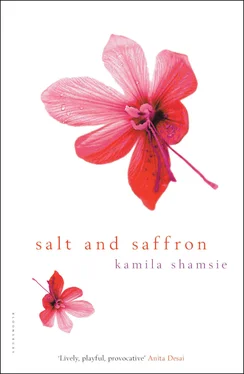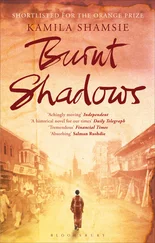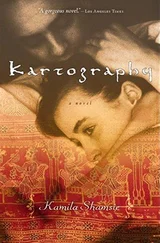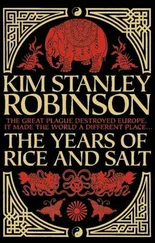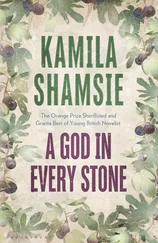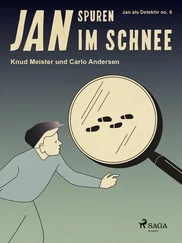Taj, the midwife, was summoned. A woman whose veins stood up a centimetre from the backs of her hands, Taj had delivered every member of my family born in Dard-e-Dil since 1872. By the time my great-grandfather was envisioning all the honours he would receive for investigating lactose colouration Taj was so shrunken and wrinkled that rumour had it she was regressing into babyhood and was only awaiting a suitable womb into which she could tunnel and complete the circle of her life.
When she entered my great-grandmother’s bedroom, dressed as always in a gharara and looking like a deep-fried shrimp with wide, embroidered cotton trousers in place of a tail, all the hovering women, relatives and servants alike, scurried out. Only the Begum of Dard-e-Dil attempted to stay with her kinswoman and childhood friend through the birth, but Taj raised an eyebrow at her and, though the Begum may not have scurried, she did leave with a haste that was less than regal. It was all very well to have titles, and sufficient gold to cover all the streets and fields of Dard-e-Dil and still have enough to gild all the mango trees, but that didn’t allow you to stand up to Taj, who had the family’s umbilical cords. I kid you not. She never left a delivery room without one.
(Trace back the origins of the Urdu expression of disdain — ‘Who do you think you are? Was your umbilical cord buried here?’ — and you might just find it was first used to insult a member of the Dard-e-Dil family born between 1872 and 1920.)
Where, if at all, did Taj bury those Dard-e-Dil umbilical cords? No one knows. In 1890, immediately after my great-grandfather’s cousin, the Nawab of Dard-e-Dil (Binky to his intimates), was born, his father, the hairless Nawab, told one of his courtiers to follow Taj when she left the palace and find out what she did with the umbilical cord. (The fear of not-quite-twins had been with the Dard-e-Dil family for over three and a half centuries at this point, and a miasma had arisen out of history to waft over any irregularity related to childbirth.) The courtier was discovered, two days later, in a neighbouring state, stealing pork from the kitchen of the British Residency. He could offer no explanation for this act. After that, no one tried following Taj again. The hairless Nawab earned a reputation for his strong sense of justice by deciding that an umbilical cord, even a royal one, was not worth forfeiting a True Believer’s place in heaven. It was pork, you understand, not theft, that marked the courtier for hell.
But I doubt any of this was on my great-grandmother’s mind as she pushed and pushed and pushed and Taj held up first one and then another and then another baby boy, and said, ‘Did you hear the midnight chimes?’
The quality of my great-grandmother’s shrieks was different enough from her labour cries to bring the women of the family rushing back into the room. Taj handed the triplets to the Begum, who was the first through the door, and then disappeared out of the room, out of the palace, out of my family’s life, three twined and bloodied umbilical cords in her hand.
So, three sons. One born just before midnight, on 28 February. One born just after midnight, on 29 February. One born at midnight, on the cusp of the leap year, his head emerging on 28 February, the rest of his body following the next day. My great-grandmother couldn’t have been more successful in birthing not-quite-twins if she’d planned it. Though I don’t suppose you can plan a thing like that. Of course, everyone still blamed Taj for the whole thing, quite overlooking her previous forty-eight years of midwifery, during which there were no not-quites and only three stillbirths.
‘As a feminist I feel I should object to the Taj story.’ I was lying flat on the floor so that Samia could pound airport tension out of my spine, my voice rising and falling with every thump. ‘I mean look, it’s got two of the archetypal female elements. The crone and the mother. The only thing it needs to fulfil all stereotypes is the virgin.’
‘Well, don’t look at me.’ Samia practised dance steps along my back.
‘I think you’ve just paralysed me.’
‘Such gratitude!’ Samia lay down and rested her head against my back. More than anything else, more than mangoes, gol guppas, nihari and naans, more than cricket mania, more than monsoon rains, more than crabbing beneath a star-clustered sky, what I missed about Karachi was the intimacy of bodies.
‘Besides,’ Samia said, ‘aren’t crones full of … What’s that term? You know, like Ego in Oh Hello?’
‘Iago in Othello. I hope you’re just trying to be funny.’ I traced the lozenge-shaped pattern on the rug with my forefinger and remembered playing a strange form of hopscotch in my grandmother’s bedroom, along with Samia and her brother Sameer, with the geometrical designs on Dadi’s carpet standing in as hopscotch squares.
‘Motiveless malignancy, that’s it. Can’t get into Crone School without it. But Taj had a reason the size of Everest to hate the family.’
‘If you’re willing to consider the possibility that Iago is in love with Othello, then—’
‘Oh, shut up. Who cares?’ Samia rolled over, propped her head on her hand and looked at me. ‘But listen, is it true that you once asked your Dadi if Taj’s name appears on our family tree?’
‘No.’ Until Samia asked that question it hadn’t really occurred to me that, yes, Taj was family too. God, it was even larger than I had thought, this pool of my relatives out in the world, generations of people with Samia’s hair, my father’s eyes, Mariam Apa’s smile, and if I saw one of those cousins on a street would I recognize something in them, would I say, We’ve never met but I know the jut of your clavicle, the curve of it. And what if, what if, in addition to the hair, the smile, the collarbone straining against the skin, what if there were also veins rising a centimetre above the backs of the hands?
‘Really?’ The disappointed voice of someone who’s just had a family myth shattered. ‘You never said anything like that at all?’
‘Nuh-uh. Though there was that time I got frightened by a squirrel and Dadi just looked at me in such disgust and said something like, “And to think you are descended from the Nawab who killed a tiger with his bare hands.” And I—’
‘Did you just say, a squirrel?’
‘It was a big squirrel. And I said to Dadi, “That paragon of bravery you just mentioned — isn’t he the same guy who raped Taj’s mother?”’
‘No, wait!’ Samia held up her hand for silence. ‘Let me guess. She said, of course it wasn’t rape. He was a Nawab.’
‘Worse. She recited “Leda and the Swan”.’
Samia fell forward, laughing. ‘Abida Nani! Always full of surprises.’
If you’re trying to understand how exactly Samia and I are related you might suppose from Samia’s words that my Dadi is her Nani, which means my father and Samia’s mother are siblings and, therefore, Samia and I are first cousins. It’s never that simple. Dadi is my father’s mother; she is not, however, Samia’s mother’s mother as Samia’s use of the term ‘Nani’ implies, but rather Samia’s mother’s mother’s sister, and so Samia and I are second cousins. While I’m climbing up the family tree let me add that my grandparents, Dadi and Dada, or Abida and Akbar if you prefer the familiarity of first names, were also second cousins, and Dada was one of those three sons, the not-quite-twins, who brought such heartache to the family. But that comes later. Of course, it really came earlier.
‘You can laugh,’ I said, looking up at the painting of an emperor and his courtiers on a hunt, which has hung in the flat as long as I can remember. The emperor on a horse, surrounded by armed men on foot. What courtier would ever allow a ruler to get within wrestling distance of a tiger? ‘But it really sums up Dadi’s view of royalty. The Nawab as Zeus; I mean, consider the implications. She thinks he was a god. And he wasn’t even a Nawab when he raped Taj’s mother. He was still just heir apparent. Not that I’m saying the title or lack thereof makes the slightest difference.’
Читать дальше
